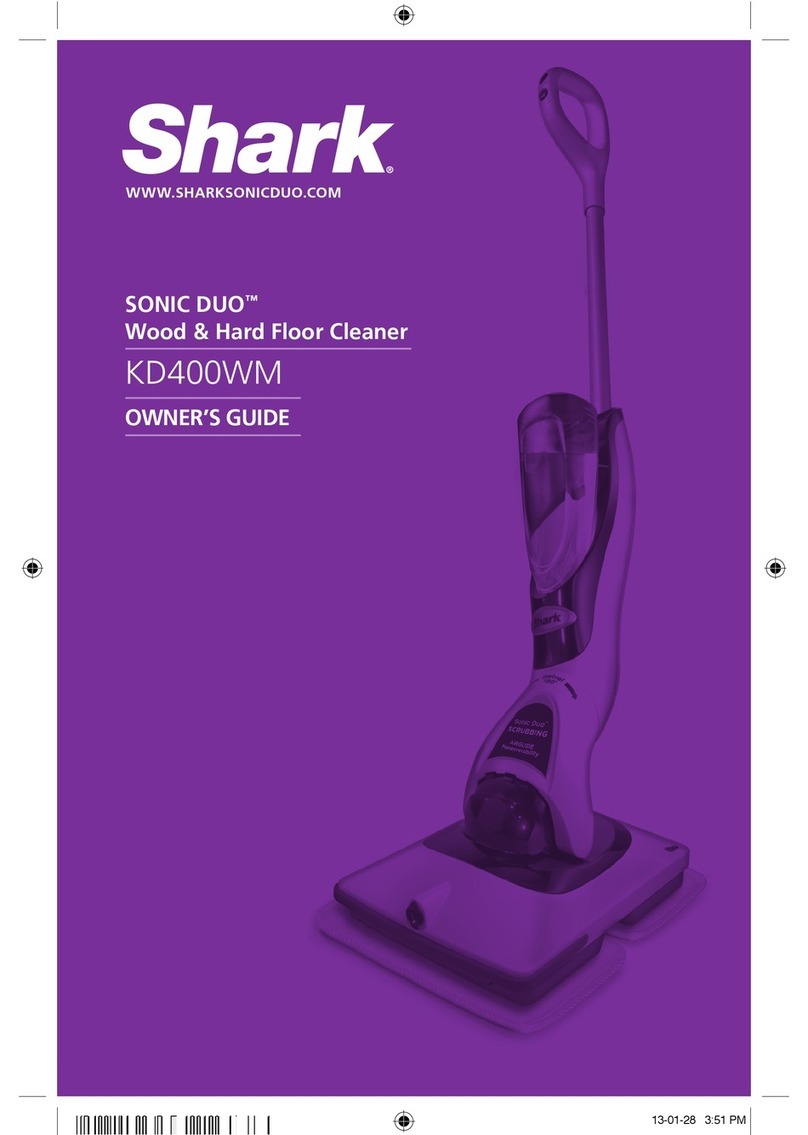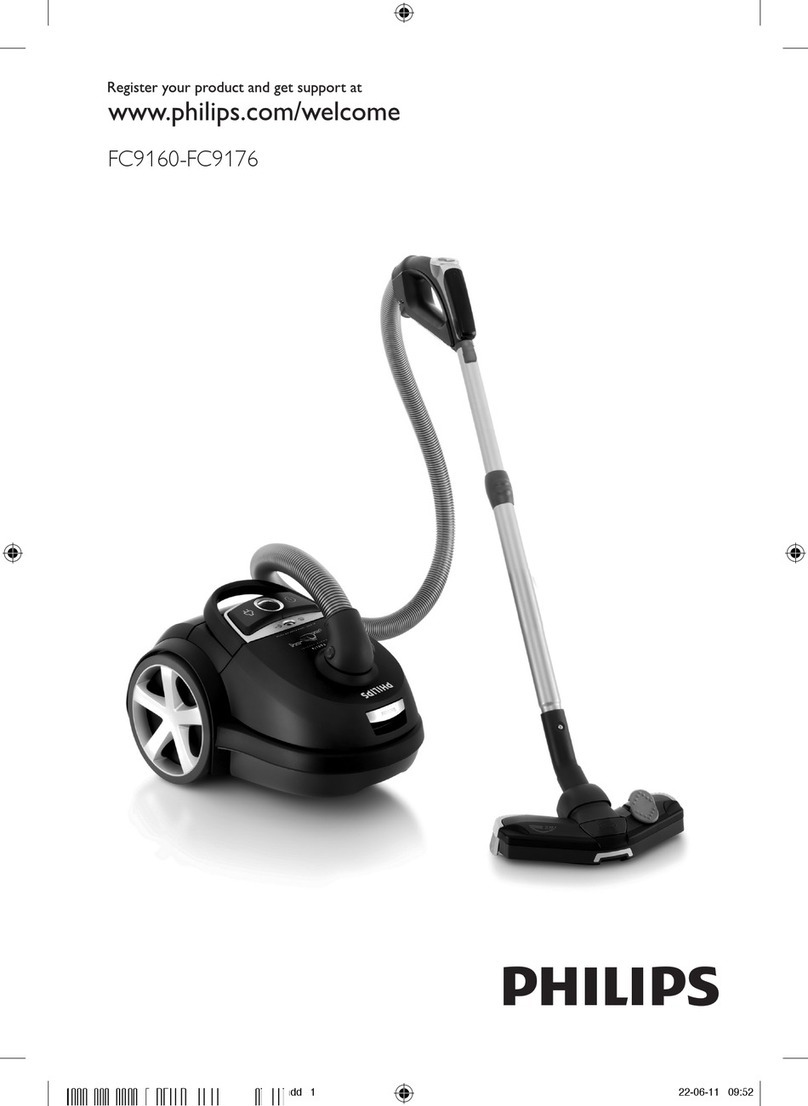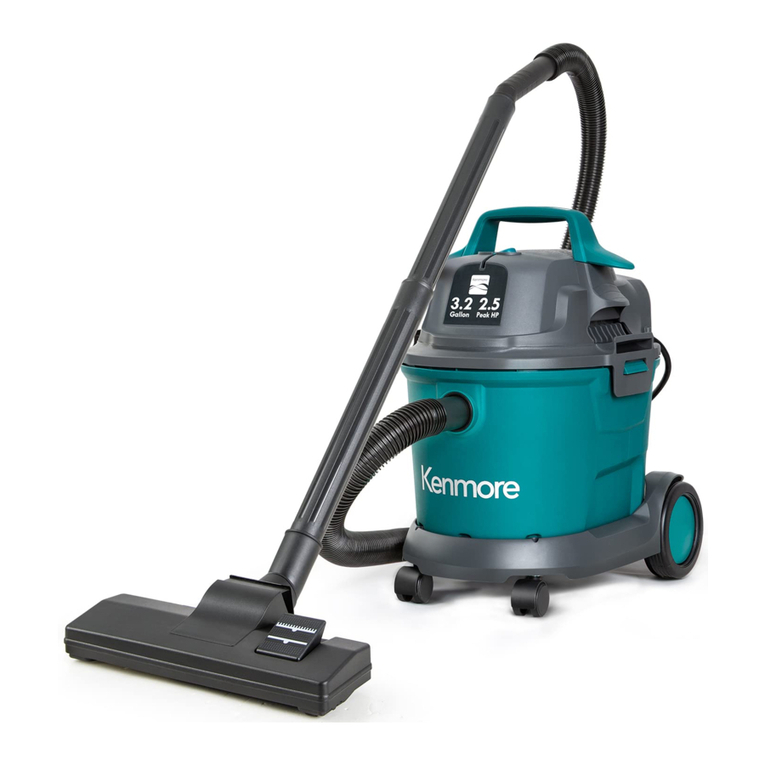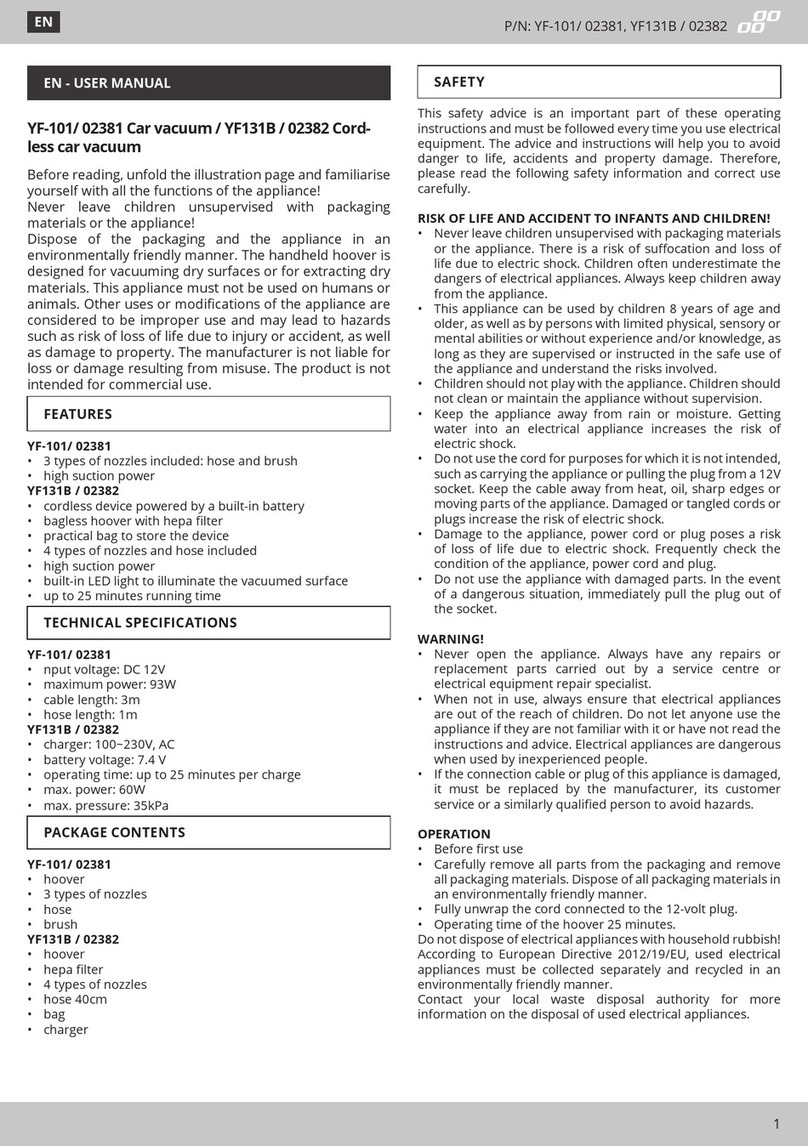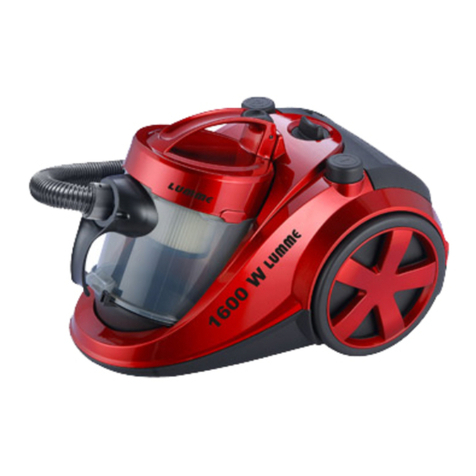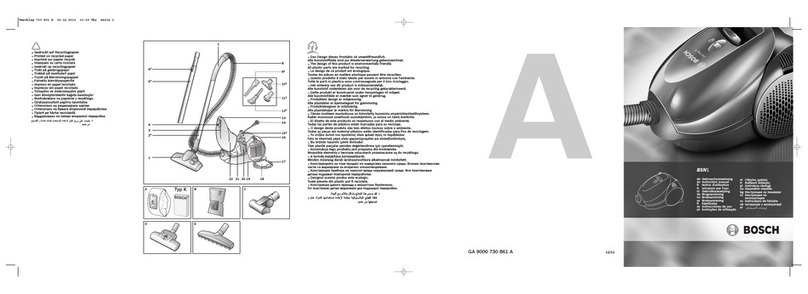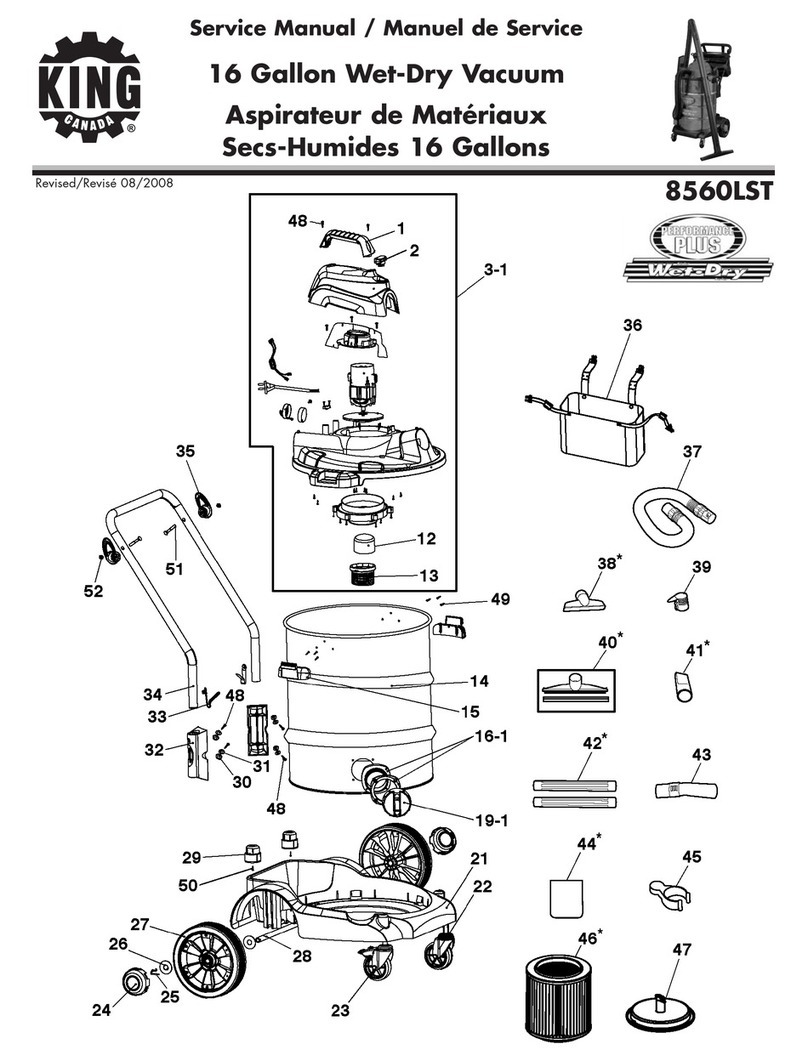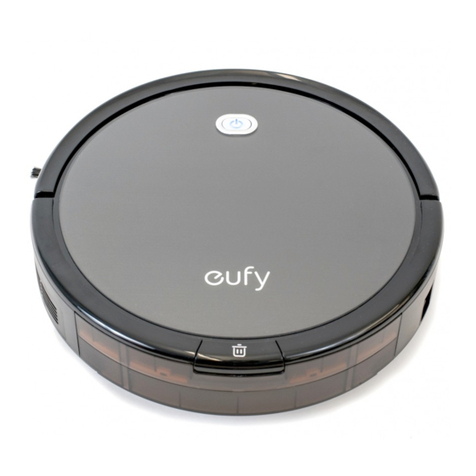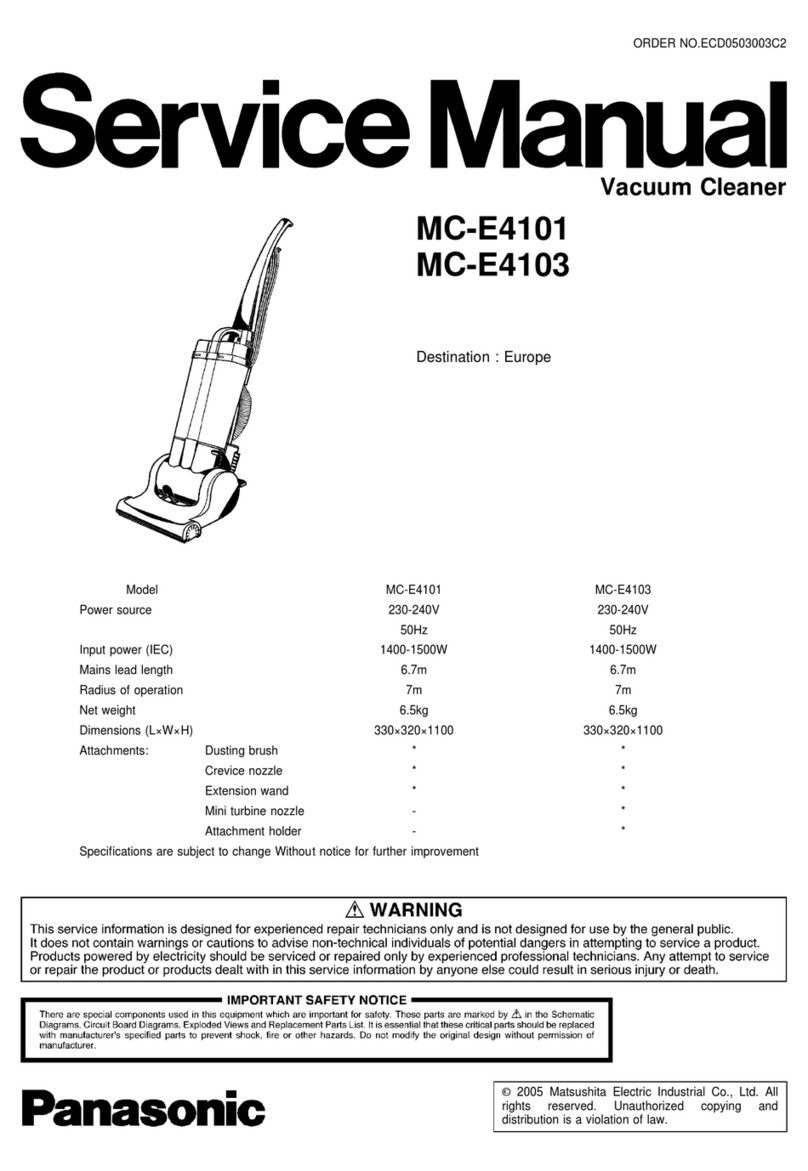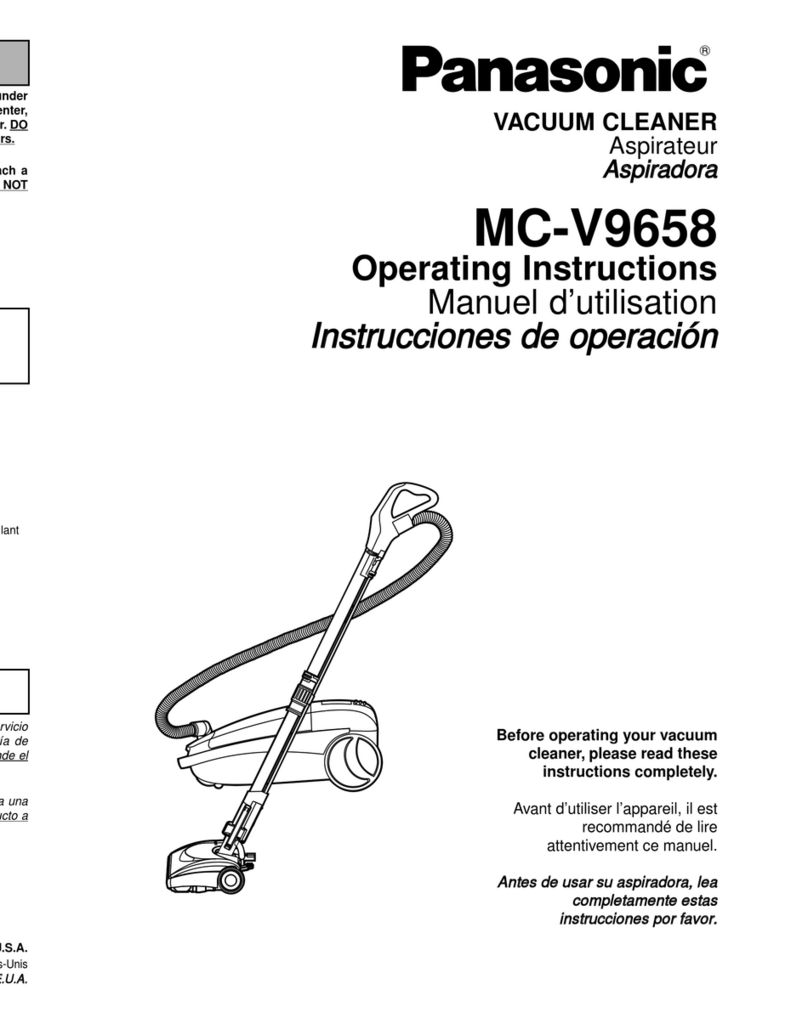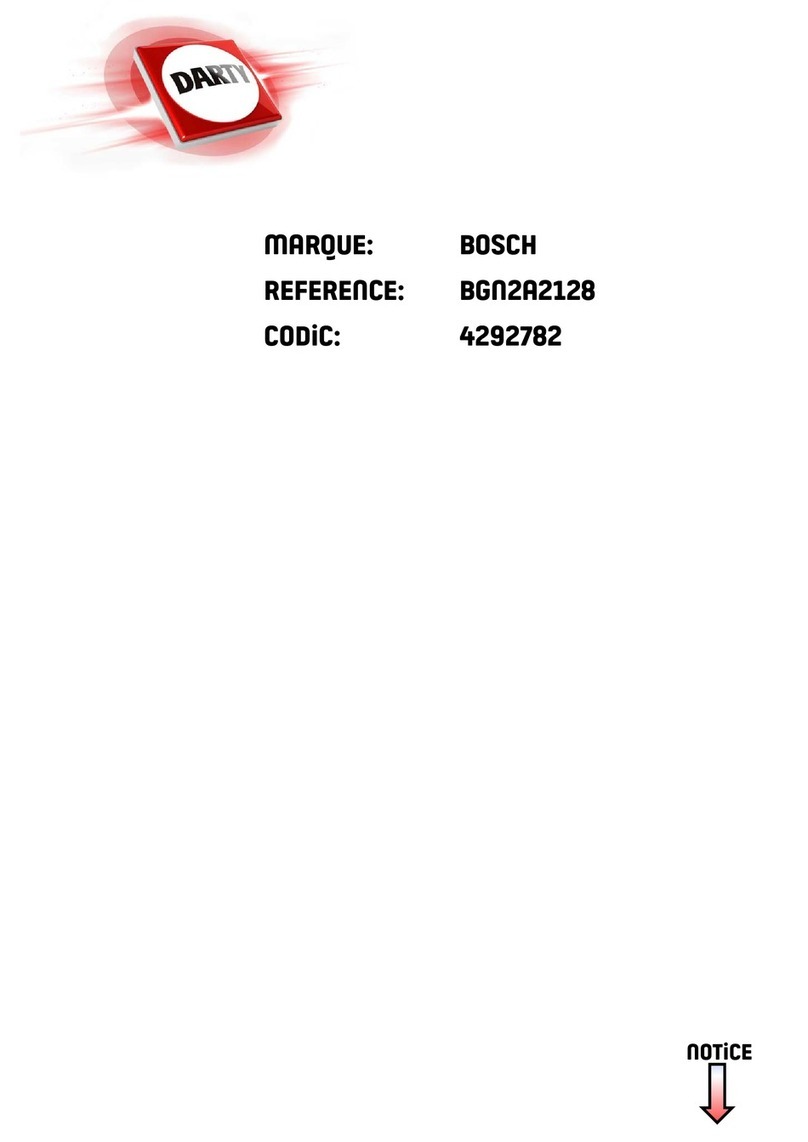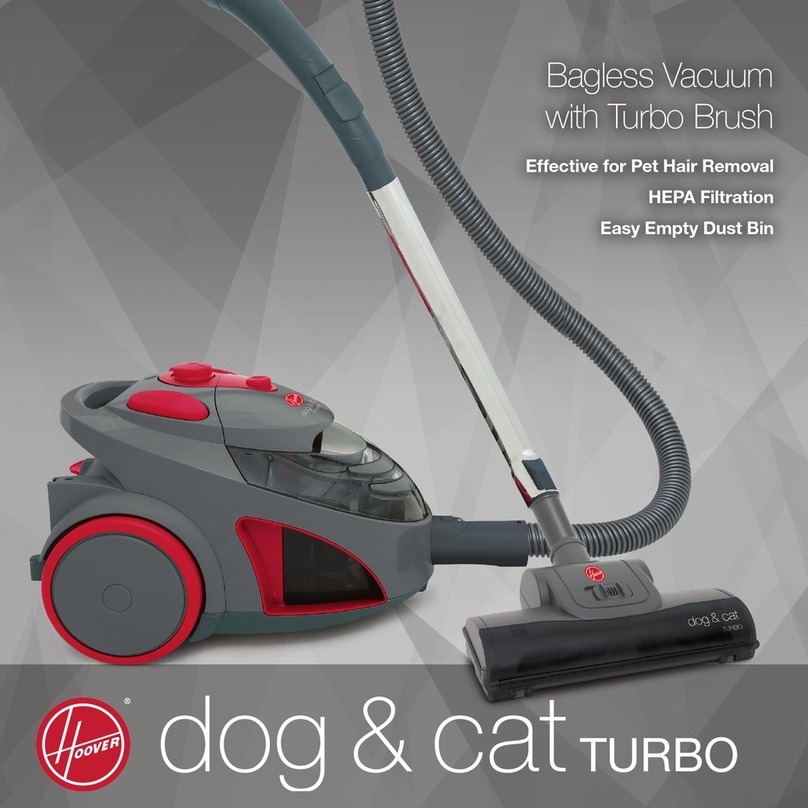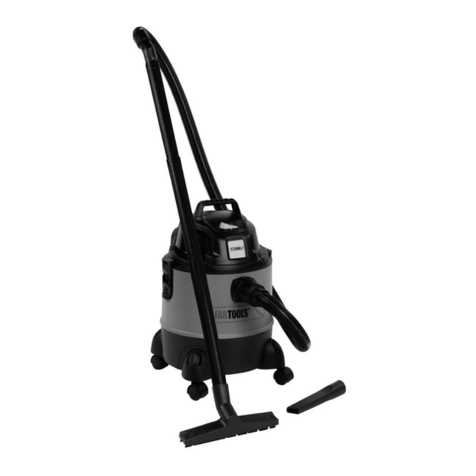Edco VAC-290 Assembly instructions

Printed in USA
TVW ©2008
Page 1
E-VAC290&VAC200-I-0808
100 Thomas Johnson Drive, Frederick, MD 21702-4600 USA
Phone (301) 663-1600 • 1-800-638-3326
Fax (301) 663-1607 • 1-800-447-3326
Website: www.edcoinc.com
Email: [email protected]
VAC-200
Operator’s Instruction Manual
EDCO VAC-290&VAC-200
INDUSTRIAL VACUUM SYSTEMS
Manual - Portable Dry Dust Removal
VAC-290

Printed in USA
©2008 TVW
Page 2
100 Thomas Johnson Drive, Frederick, MD 21702-4600 USA
Phone (301) 663-1600 • 1-800-638-3326
Fax (301) 663-1607 • 1-800-447-3326
Website: www.edcoinc.com
Email: [email protected]
E-VAC290&VAC200-I-0808
READ AND UNDERSTAND THE OPERATORS INSTRUCTION MANUAL THOROUGHLY
BEFORE ATTEMPTING TO OPERATE THIS EQUIPMENT.
Death or serious injury could occur if this machine is used improperly.
Extreme care must be taken when operating electric
models with water present: Ensure power cord is prop-
erly grounded, is attached to a Ground-Fault-Interrupter
(GFI) outlet, and is undamaged.
•Check all electrical cables - be sure connections are tight and
cable is continuous and in good condition. Be sure cable is
correctly rated for both the operating current and voltage of
this equipment.
•Improper connection of the equipment-grounding conductor can
result in a risk of electric shock. Check with qualified electri-
cian or service person if there is any doubt as to whether the
outlet is properly grounded. Adhere to all local codes and
ordinances.
•NOTE: In the event of a malfunction or breakdown, grounding
provides a path of least resistance for the electric current to
dissipate. The motor is equipped with a grounded plug and
must be connected to an outlet that is properly installed and
properly grounded. DO NOT modify the plug provided on the
motor. If the plug does not fit the outlet have a qualified electri-
cian install the proper receptacle.
•Switch motor OFF before disconnecting power.
•Engine exhaust from this product contains
chemicals known to the State of California to
cause cancer, birth defects or other reproduc-
tive harm.
•Gasoline is extremely flammable and poisonous.
It should only be dispensed in well ventilated areas,
and with a cool engine.
•Small gasoline engines produce high concentra-
tions of carbon monoxide (CO) example: a 5 HP 4 cycle
engine operation in an enclosed 100,000 cu. ft. area with
only one change of air per hour is capable of providing
deadly concentrations of CO in less than fifteen minutes.
Five changes of air in the same area will produce noxious
fumes in less than 30 minutes. Gasoline or propane pow-
ered equipment should not be used in enclosed or partially
enclosed areas. Symptoms of CO poisoning include, head-
ache, nausea, weakness, dizziness, visual problems and
loss of consciousness. If symptoms occur - get into fresh
air and seek medical attention immediately.
SAFETY
MESSAGES
SAFETY MESSAGES
Indicates an imminent hazard which, if not
avoided, will result in death or serious injury.
Indicates an imminent hazard which, if not
avoided, can result in death or serious injury.
Indicates hazards which, if not avoided, could
result in serious injury and or damage to the
equipment.
•Safety Instructions are proceeded by a graphic alert symbol
of DANGER, WARNING, or CAUTION.
ELECTRICAL POWERED EQUIPMENT
GASOLINE/PROPANE POWERED EQUIPMENT
•Equipment should only be operated by trained personnel in
good physical condition and mental health (not fatigued). The
operator and maintenance personnel must be physically able
to handle the bulk weight and power of this equipment.
•This is a one person tool. Maintain a safe operating distance
to other personnel. It is the operators’ responsibility to keep
other people (workers, pedestrians, bystanders, etc.) away
during operation. Block off the work area in all directions with
roping, safety netting, etc. for a safe distance. Failure to do so
may result in others being injured by flying debris or exposing
them to harmful dust and noise.
•This equipment is intended for commercial use only.
•For the operator’s safety and the safety of others, always keep
all guards in place during operation.
•Never let equipment run unattended.
•Personal Protection Equipment and proper safety attire must
be worn when operating this machinery. The operator must
wear approved safety equipment appropriate for the job such
as hard hat and safety shoes when conditions require. Hear-
ing protection MUST be used (operational noise levels of this
equipment may exceed 90db). Eye protection MUST be worn
at all times.
Keep body parts and loose clothing away from moving
parts. Failure to do so could result in dismemberment
or death.
•Do not modify the machine.
•Stopmotor/enginewhenadjustingorservicingthisequipment.
Maintain a safe operating distance from flammable
materials. Sparks from the cutting-action of this machine
can ignite flammable materials or vapors.
GENERAL INSTRUCTIONS
DUST WARNING
Some dust created by power sanding, sawing,
grinding, drilling, and other construction activi-
ties contains chemicals known to cause cancer,
birth defects, or other reproductive harm. Some
examples of these chemicals are:
•Lead from lead-based paints, and
•Crystalline silica from bricks and concrete and other
masonry products.
Your risk of exposure to these chemicals varies depending
on how often you do this type of work. To reduce your risk:
work in a well ventilated area, use a dust control system, such
as an industrial-style vacuum, and wear approved personal
safety equipment, such as a dust/particle respirator designed
to filter out microscopic particles.
•Donotdisconnectpowerbypullingcord.Todisconnect,grasp
the plug, not the cord.
•Unplug power cord at the machine when not in use and before
servicing.

Printed in USA
TVW ©2008
Page 3
E-VAC290&VAC200-I-0808
100 Thomas Johnson Drive, Frederick, MD 21702-4600 USA
Phone (301) 663-1600 • 1-800-638-3326
Fax (301) 663-1607 • 1-800-447-3326
Website: www.edcoinc.com
Email: [email protected]
“A”
“B”
“C”
Weight
20” (50.8mm)
51” (129.5mm)
32” (81mm)
169 lbs. (76.6kg)
VAC-290 VAC-200
SPECIFICATIONS
Note:
All dimensions and
weights are for
reference only
and subject to change at
any time.
HOW TO ORDER REPAIR PARTS
To insure product safety and reliability, always use genuine
EDCO replacement parts when making repairs to the equip-
ment.
When ordering parts, please specify the MODEL and SERIAL
NUMBER of the machine as given on the NAMEPLATE. In
addition, give part number, description and quantity as listed
on the parts list.
Please note: Due to improvements and changes in the equip-
ment the illustrations shown may be different from the actual
machine.
Toll Free: Phone 1-800-638-3326 • Fax 1-800-447-3326
Figure 1
Section Page Number
Table of Contents
Safety Instructions.....................................................................................................2
Specifications............................................................................................................3
Safey Guidelines & Safety........................................................................................4-5
Start-Up VAC-200 & VAC-290...................................................................................5
Inspection & Maintenance VAC-200.........................................................................6-8
Inspection & Maintenance VAC-290.........................................................................8-10
Trouble Shooting VAC-200 & VAC-290......................................................................11
SMI Dust and Silica Warning......................................................................................11
Limited Equipment Warranty..............................................................................Back Page
20” (50.8mm)
35” (89mm)
32” (81mm)
90 lbs. (40.8kg)
Note: VAC-290
Shown
B
A
C

Printed in USA
©2008 TVW
Page 4
100 Thomas Johnson Drive, Frederick, MD 21702-4600 USA
Phone (301) 663-1600 • 1-800-638-3326
Fax (301) 663-1607 • 1-800-447-3326
Website: www.edcoinc.com
Email: [email protected]
E-VAC290&VAC200-I-0808
Guidelines
Safety warnings and guidelines do not by themselves eliminate danger.
They are not substitutes for proper accident prevention procedures and good judgement.
Read and understand this Operator’s Instruction Manual,
and the Engine Manufacturer’s Owner’s Manual
before operating this equipment.
Death of serious injury can result if this machine is used improperly.
Eye and ear protection must be worn at all times while the saw is in use. During normal
operation, sound pressure levels exceed 92dBA. Use only ANSI approved safety glasses
to help prevent eye injury. Standard eyeglasses have only impact resistant lenses; they are
NOT safety glasses.
Operator must wear appropriate clothing and footwear. Do not wear loose clothing or jewelry
that can get tangled in moving parts. Footwear should provide sure footing and protection
from debris that may be dropped. Take steps to insure hair will not be caught in moving parts.
If necessary, tie it back.
• When loading or unloading the saw, use caution. Make sure rolling table is locked so that the blade will not be
damaged. Do not move the saw while the engine is running.
• Never exceed the maximum operating speed of the blade. Match the blade speed rating with the arbor shaft
speed.
• Never leave the saw running unattended.
• Never operate this saw under the influence of drugs, alcohol or when taking medications that impair the senses or
reactions, or when excessively tired or under stress.
• Do not lend or rent this equipment without including the Operator’s Instruction Manual and the Engine Manufac-
turer’s Manual.
• Make sure all safety decals can be clearly read and understood. Replace damaged or missing decals immedi-
ately.
For Electric Models:
• Electric motor must be properly grounded at all times. Check the outlet box to be sure the electrical service is
properly grounded and that adequate power is available. Insufficient power will cause motor to overheat and burn
out. Use only grounded extension cords correctly sized for the current draw and voltage drop (amp rating and
length). Never use frayed, damaged, taped or underrated extension cords. Electrical shock could result in death
or serious injury and damage to the equipment.
Dry cutting creates a large volume of airborne dust. For health reasons, the operator should wear
an applicable respirator. The dust may contain chemicals known to cause serious illnesses, in-
cluding Silicosis - a fatal disease of the lungs. Check the chemical properties of the material to be
cut and follow all EPA/OSHA regulations.

Printed in USA
TVW ©2008
Page 5
E-VAC290&VAC200-I-0808
100 Thomas Johnson Drive, Frederick, MD 21702-4600 USA
Phone (301) 663-1600 • 1-800-638-3326
Fax (301) 663-1607 • 1-800-447-3326
Website: www.edcoinc.com
Email: [email protected]
Safety VAC-200 & VAC-290
CAUTION: Standard EDCO machines are not to be used for the removal of liquids or any volatile, viscous,
flammable or explosive media. If you are unsure about your application requirements consult your EDCO
representative.
CAUTION: Standard EDCO VAC machines are designed for intermittent use, i.e. not more then 2 hours continuously. If
you are unsure about your application requirements consult your EDCO representative.
CAUTION: A dust mask should be worn when working with used filters.
CAUTION: Disconnect the machine from the power source before and during inspection and/or maintenance.
CAUTION: Machines equipped with a reverse pulse module must always be supplied adequately when the machine is
on. The module is controlled by an electrical sequential timer (requires a 110 volt power supply) or differential pressure
switch. The module itself requires a source of compressed air of 90 PSI at 2-4 CFM (depending on module). This device
prevents the accumulation of material on the filter and therefore prevents the machine from being held under excessive
stresses due to material blockage.
CAUTION: Machines equipped with a motorized shaker must be supplied with a three phase, 230-460 volt (depending
on motor) power supply when ever the machine is on. The motorized shaker is controlled by an electrical sequential
timer (requires a 110 volt power supply), a differential pressure switch or a manual switch. Manual switch models should
be actuated before and after every use while the vacuum is off. This device prevents the accumulation of material on the
filter and therefore prevents the machine from being held under excessive stresses due to material blockage.
Start-Up VAC-200
1. Pull up on the foot lever to release the dustpan. Check that the dustpan is completely empty then replace.
CAUTION: The electrical service at the installation site must supply the voltage stamped on the machine’s serial tag.
Most motors have multiple voltage capabilities that may appear on the motor serial tag but do not apply to the specific
machine. Operating at an incorrect voltage may damage the machine.
NOTE: A qualified electrician in accordance with the National Electric Code and all local codes should perform all
wiring and/or electrical adjustments during installation and servicing.
2. Connect the machine to the proper power source, as indicated on the machine’s serial tag.
3. Start the machine by pushing the power switches on the motors to the ON/closed position one at a time.
4. Turn the machine off by pushing the power switches on the motors to the OFF/open position.
5. The filter should be shaken and the dustpan emptied before and after every use.
NOTE: The following instructions are for models VAC-200 & VAC-290 except where noted. The instructions are very
similar but are different in several ways. Please pay special attention where differences are noted for models.
Start-Up VAC-290
1. Pull up on the foot lever to release the dustpan. Check that the dustpan is completely empty then replace.
CAUTION: The electrical service at the installation site must supply the voltage stamped on the machine’s serial tag.
Most motors have multiple voltage capabilities that may appear on the motor serial tag but do not apply to the specific
machine. Operating at an incorrect voltage may damage the machine.
NOTE: A qualified electrician in accordance with the National Electric Code and all local codes should perform all
wiring and/or electrical adjustments during installation and servicing.
2. Connect the machine to the proper power source, as indicated on the machine’s serial tag.
3. Start the machine by pushing the power switches on the control panel to the ON/closed position one at a time.
4. Turn the machine off by pushing the power switches on the control panel to the OFF/open position.
5. The filter should be shaken and the dustpan emptied before and after every use.

Printed in USA
©2008 TVW
Page 6
100 Thomas Johnson Drive, Frederick, MD 21702-4600 USA
Phone (301) 663-1600 • 1-800-638-3326
Fax (301) 663-1607 • 1-800-447-3326
Website: www.edcoinc.com
Email: [email protected]
E-VAC290&VAC200-I-0808
Inspection and Maintenance VAC-200
Standard Filter Inspection
1. Turn the machine off.
2. Knock material off the filter via the hand shaker, motorized shaker or reverse pulse.
3. Pull up on the foot lever to release the dustpan then remove and empty if necessary.
4. Lock the rear casters then carefully tip the machine back onto the push handle.
5. Remove any material between the pleats, by hand only.
CAUTION: Clogged material should only be removed by hand. Using an object to dislodge material may tear the filter.
Consult your EDCO representative if material blockage is excessive.
6. Inspect the pleats of the filter for tears and material blockage.
7. Carefully tip the machine back onto the casters and replace the dustpan.
Standard Filter Removal
1. First follow the preceding filter inspection procedure to determine if removal is necessary.
2. Turn the machine on then block the inlet with a flat and rigid material to place the machine under vacuum pressure.
3. Remove all of the housing-component socket truss screws with a 5/32 hex-wrench.
4. Turn the machine off and disconnect the power source.
5. Separate the motor deck from the housing then disconnect the motor deck ground wire from the push-on terminal.
6. Disconnect the three power cord wires from the terminal block on the underside of the motor deck.
7. Remove the motor deck.
8. Disconnect the clear differential pressure gage tubes from their respective barbed fittings if so equipped.
9. Remove the HEPA filter housing spacer and HEPA adapter assembly if so equipped; make sure to disconnect the
HEPA adapter assembly ground wire via push-on terminal before removing.
10. Remove the reverse pulse/motorized shaker assembly and housing spacer if so equipped; make sure to
disconnect the component ground wire via push-on terminal before removing.
11. Inspect the top of the filter for material.
NOTE: The presence of material in this area or in the exhaust is often the result of a misaligned seal or damaged
filter. Consult your EDCO representative if either is the case.
12. Remove the filter housing spacer assembly; make sure to disconnect the filter housing spacer assembly ground
wire from the base via push on terminal.
13. Turn the filter housing spacer assembly over on a table then work the filter off the filter shaker insert.
Motor Brushes Inspection
1. Turn the machine off then disconnect the power source.
2. Disconnect both motor terminals.
3. Loosen the motor retaining knobs enough to remove both motors.
4. Remove the 12 screws from the bottoms of the motor assemblies.
5. Remove the plastic motor covers to access the tops of the motors.
6. Remove the 2 metal motor-cap-retaining clips per motor.
7. Carefully dislodge the plastic motor cap via the built in hooks on both sides of each motor brush.
(TIP: Dislodge one side of a cap first, then the other.)
8. Remove the motor brush retainers via the 2 phillips screws per brush.
9. Remove each of the brushes and inspect for excessive or uneven wear.
NOTE: A brush should be replaced if its length is less than 0.25 inches.
10. Reverse the procedure to install the brushes.
11. Reassemble and secure both motor assemblies with the 12 motor cover screws. Do not over tighten the screws,
as the cover will crack.
12. Position both motors in the deck and secure with the motor retaining knobs.
13. Connect both motor terminals.

Printed in USA
TVW ©2008
Page 7
E-VAC290&VAC200-I-0808
100 Thomas Johnson Drive, Frederick, MD 21702-4600 USA
Phone (301) 663-1600 • 1-800-638-3326
Fax (301) 663-1607 • 1-800-447-3326
Website: www.edcoinc.com
Email: [email protected]
Standard Filter Installation VAC-200
1. Turn the filter housing spacer assembly over on a table then fit the filter over the filter shaker insert.
2. Make sure each pleat is fully supported and the ground wire is on the filter side of the assembly.
3. Connect the filter housing spacer assembly ground wire to the base via the push–on terminal.
4. Seat the filter housing spacer assembly on the base oriented as it was removed.
5. Seat the reverse pulse/motorized shaker assembly and housing spacer (if so equipped) on the filter housing spacer
assembly oriented as removed; make sure to connect the component ground wire to the filter housing spacer assem-
bly via push-on terminal.
6. Seat the HEPA adapter assembly and housing spacer (if so equipped) on the preceding housing component
oriented as removed; make sure to connect the component ground wire to the preceding assembly via push on
terminal.
7. Connect the motor deck ground wire to the preceding assembly.
8. Connect the three power cord wires to the their respective terminals in the terminal block on the underside of the
motor deck.
9. Seat the motor deck on the preceding housing spacer.
10. Connect the clear differential pressure gauge tubes to their respective barbed fittings if so equipped.
11. Turn the machine on then block the inlet with a flat and rigid material to place the machine under vacuum
pressure.
12. Secure all of the housing-components then turn the machine off.
HEPA Filter Replacement Procedure VAC-200
NOTE: The differential pressure gage measures the pressure above, against the pressure below the HEPA filter,
thereby measuring the restriction of airflow through the filter. Filters should be replaced when the gauge consistently
reads 4 inches W.C.
1. Turn the machine on then block the inlet with a flat and rigid material to place the machine under vacuum pressure.
2. Remove the motor deck socket truss screws.
3. Turn the machine off and disconnect the power source.
4. Unscrew the cable grip in the HEPA filter housing spacer.
5. Push about a foot of the power cord into the HEPA filter housing spacer.
6. Separate the motor deck from the HEPA filter housing spacer then disconnect the motor deck ground wire from the
HEPA filter adapter plate assembly via the push-on terminal.
7. Disconnect the three power cord wires from the terminal block on the underside of the motor deck.
8. Remove the motor deck.
9. Remove the four lock nuts retaining the two HEPA filter brackets.
10. Remove the ring-to-tab terminal, HEPA filter brackets and HEPA filter.
11. Center the new filter on the HEPA adapter plate, gasket side down.
12. Position the provided lengths of self-adhering flat gasket material on the HEPA filter frame (if not already done so)
to cushion the HEPA filter brackets.
13. Replace the HEPA filter brackets and ring-to-tab terminal then thread the locking nuts over the rods and tighten.
CAUTION: Do not over tighten. The effectiveness of the filter may be compromised if its frame is bent.
14. Set the motor deck on the HEPA filter housing spacer.
15. Connect the three power cord wires to the their respective terminals in the terminal block on the underside of the
motor deck.
16. Connect the motor deck ground wire to the HEPA adapter plate assembly via the push-on terminal then seat the
motor deck on the HEPA filter housing spacer.
17. Pull any unnecessary slack in the power cord back through the cable grip then secure the cable.
18. Connect the power source.
19. Turn machine on then block the inlet with a flat and rigid material to place the machine under vacuum pressure.
20. Secure the motor deck then turn the machine off.

Printed in USA
©2008 TVW
Page 8
100 Thomas Johnson Drive, Frederick, MD 21702-4600 USA
Phone (301) 663-1600 • 1-800-638-3326
Fax (301) 663-1607 • 1-800-447-3326
Website: www.edcoinc.com
Email: [email protected]
E-VAC290&VAC200-I-0808
Motor Brushes Inspection
1. Turn the machine off then disconnect the power source.
2. Disconnect both motor terminals.
3. Loosen the motor retaining knobs enough to remove both motors.
4. Remove the 12 screws from the bottoms of the motor assemblies.
5. Remove the plastic motor covers to access the tops of the motors.
6. Remove the 2 metal motor-cap-retaining clips per motor.
7. Carefully dislodge the plastic motor cap via the built in hooks on both sides of each motor brush.
(TIP: Dislodge one side of a cap first, then the other.)
8. Remove the motor brush retainers via the 2 phillips screws per brush.
9. Remove each of the brushes and inspect for excessive or uneven wear.
NOTE: A brush should be replaced if its length is less than 0.25 inches.
10. Reverse the procedure to install the brushes.
11. Reassemble and secure both motor assemblies with the 12 motor cover screws. Do not over tighten the screws,
as the cover will crack.
12. Position both motors in the deck and secure with the motor retaining knobs.
13. Connect both motor terminals.
Inspection and Maintenance VAC-290
Standard Filter Inspection
1. Turn the machine off.
2. Knock material off the filter via the hand shaker, motorized shaker or reverse pulse.
3. Pull up on the foot lever to release the dustpan then remove and empty if necessary.
4. Lock the rear casters then carefully tip the machine back onto the push handle.
5. Remove any material between the pleats, by hand only.
CAUTION: Clogged material should only be removed by hand. Using an object to dislodge material may tare the filter.
Consult your EDCO representative if material blockage is excessive.
6. Inspect the pleats of the filter for tears and material blockage.
7. Carefully tip the machine back onto the casters and replace the dustpan.
Standard Filter Removal
1. Follow the preceding filter inspection procedure to determine if removal is necessary.
2. Turn the machine on then block the inlet with a flat and rigid material to place the machine under vacuum pressure.
3. Remove all of the housing-component socket truss screws with a 5/32 hex-wrench.
4. Turn the machine off and disconnect the power source.
5. Separate the motor deck from the housing then disconnect the motor deck ground wire from the push-on terminal.
6. Remove the motor deck.
7. Disconnect the clear differential pressure gauge tubes from their respective barbed fittings if so equipped.
8. Remove the HEPA filter housing spacer and HEPA adapter assembly if so equipped; make sure to disconnect the
HEPA adapter assembly ground wire via push-on terminal before removing.
9. Remove the reverse pulse/motorized shaker assembly and housing spacer if so equipped; make sure to discon-
nect the component ground wire via push-on terminal before removing.
10. Inspect the top of the filter for material.
NOTE:
The presence of material in this area or in the exhaust is often the result of a misaligned seal or damaged filter. Con-
sult your EDCO representative if either is the case.
11. Remove the filter housing spacer assembly; make sure to disconnect the ground wire via push on terminal.
12. Turn the filter housing spacer assembly over on a table then carefully work the filter off the filter shaker insert.

Printed in USA
TVW ©2008
Page 9
E-VAC290&VAC200-I-0808
100 Thomas Johnson Drive, Frederick, MD 21702-4600 USA
Phone (301) 663-1600 • 1-800-638-3326
Fax (301) 663-1607 • 1-800-447-3326
Website: www.edcoinc.com
Email: [email protected]
Standard Filter Installation VAC-290
1. Turn the filter housing spacer assembly over on a table then fit the filter over the filter shaker insert.
2. Make sure each pleat is fully supported and the ground wire is on the filter side of the assembly.
3. Connect the filter housing spacer assembly ground wire to the base via the push–on terminal.
4. Seat the filter housing spacer assembly on the base oriented as it was removed.
5. Seat the reverse pulse/motorized shaker assembly and housing spacer (if so equipped) on the filter housing spacer
assembly oriented as removed; make sure to connect the component ground wire to the filter housing spacer assem-
bly via push-on terminal.
6. Seat the HEPA adapter assembly and housing spacer (if so equipped) on the preceding housing component ori-
ented as removed; make sure to connect the component ground wire to the preceding assembly via push on terminal.
7. Connect the motor deck ground wire to the preceding assembly then seat the deck on the preceding housing
spacer.
8. Connect the clear differential pressure gage tubes to their respective barbed fittings if so equipped.
9. Turn the machine on then block the inlet with a flat and rigid material to place the machine under vacuum pressure.
10. Secure all of the housing-components then turn the machine off.
HEPA Filter Replacement Procedure VAC-290
NOTE: All HEPA filter machines are equipped with a differential pressure gauge. The gauge measures the pressure
above against the pressure below the filter, thereby measuring the restriction of airflow due to contamination. HEPA
filters should be replaced when the gauge consistently measures 4 inches W.C.
1. Turn the machine on then block the inlet with a flat and rigid material to place the machine under vacuum pressure.
2. Remove the motor deck socket truss screws.
3. Turn the machine off and disconnect the power source.
4. Separate the motor deck and HEPA filter housing spacer then disconnect the motor deck ground wire from the
HEPA adapter assembly via the push-on terminal.
5. Remove the motor deck and silencer hood together.
6. Remove the lock nuts retaining the HEPA filter brackets.
7. Remove the ring-to-tab terminal, HEPA filter brackets and HEPA filter.
8. Center the new filter on the HEPA adapter plate gasket side down.
9. Position the provided lengths of self-adhering flat gasket material on the HEPA filter frame (if not already done so)
to cushion the HEPA filter brackets.
10. Replace the HEPA filter brackets and ring-to-tab terminal then thread the locking nuts over the rods and tighten.
CAUTION: Do not over tighten. The effectiveness of the filter may be compromised if its frame is bent.
11. Set the motor deck on the HEPA filter housing spacer.
12. Connect the motor deck ground wire to the HEPA adapter plate assembly via the push-on terminal then seat the
deck on the HEPA filter housing spacer.
13. Connect the power source.
14. Turn the machine on then block the inlet with a flat and rigid material to place the machine under vacuum pres-
sure.
15. Secure the motor deck then turn the machine off.

Printed in USA
©2008 TVW
Page 10
100 Thomas Johnson Drive, Frederick, MD 21702-4600 USA
Phone (301) 663-1600 • 1-800-638-3326
Fax (301) 663-1607 • 1-800-447-3326
Website: www.edcoinc.com
Email: [email protected]
E-VAC290&VAC200-I-0808
VAC-200
Motor Brushes Inspection
1. Turn the machine off then disconnect the power source.
2. Remove the motor deck socket truss screws.
3. Remove the silencer hood assembly.
4. Remove the 4 metal motor-cap retaining clips using a standard bit screwdriver.
5. Carefully dislodge the plastic motor cap via the built in hooks on both sides of each motor brush using a standard
screwdriver. (TIP: Dislodge one side of a cap first, then the other.)
6. Remove the motor brush retainers via the 2 phillips screws per brush.
7. Remove each of the brushes and inspect for excessive or uneven wear.
NOTE: A brush should be replaced if its length is less than 0.25 inches.
8. Reverse the procedure to install each brush.
9. Replace the silencer hood; make sure the switch mount is fit into the slot in the silencer hood.
10. Secure the silencer hood with the 4 socket truss screws.
VAC-290

Printed in USA
TVW ©2008
Page 11
E-VAC290&VAC200-I-0808
100 Thomas Johnson Drive, Frederick, MD 21702-4600 USA
Phone (301) 663-1600 • 1-800-638-3326
Fax (301) 663-1607 • 1-800-447-3326
Website: www.edcoinc.com
Email: [email protected]
Grinding/cutting/drilling of masonry, concrete, metal and other materials can generate dust, mists and fumes containing chemicals
known to cause serious or fatal injury or illness, such as respiratory disease, cancer, birth defects or other reproductive harm. If
you are unfamiliar with the risks associated with the particular process and/or material being cut or the composition of the tool being
used, review the material safety data sheets and/or consult your employer, the manufacturers/suppliers, governmental agencies
such as OSHA and NIOSH and other sources on hazardous materials. California and some other authorities, for instance, have
published lists of substances known to cause cancer, reproductive toxicity, or other harmful effects.
Control dust, mist and fumes at the source where possible. In this regard use good work practices and follow the recommendations of
the manufacturers/suppliers, OSHA/NIOSH, and occupational and trade associations. Water should be used for dust suppression
when wet grinding/cutting/drilling is feasible. When the hazards from inhalation of dust, mists and fumes cannot be eliminated,
the operator and any bystanders should always wear a respirator approved by NIOSH/MSHA for the material being used.
Grinding/cutting/drilling of masonry, concrete and other materials with silica in their composition may give off dust or mists containing
crystalline silica. Silica is a basic component of sand, quartz, brick clay, granite and numerous other minerals and rocks. Repeated
and/or substantial inhalation of airborne crystalline silica can cause serious or fatal respiratory diseases, including silicosis. In
addition, California and some other authorities have listed respirable crystalline silica as a substance known to cause cancer.
When grinding/cutting/drilling such materials, always follow the respiratory precautions mentioned above.
SMI Dust and Silica Warning
Trouble Shooting VAC-290 & VAC-200
PROBLEM
Insufficient Vacuum
Pressure
Air Leaks
Material In Exhaust/
On Top Side of Filter
Unusual or High
Pitched Noises
POSSIBLE CAUSE
- Motors are not on and/or
working
- Dustpan improperly seated
- Filter clogged or improperly
seated
- Clogged hose
- Unit is improperly sealed
- Worn or poorly seated seals,
- Poor filter seal or torn
filter
- Motor bearings, Motor
brushes
- Worn or poorly seated seals,
Retainers improperly installed
CORRECTIVE ACTION
- Turn both motors on, check motor brushes
- Remove dustpan, inspect seal, replace dustpan.
- Follow filter inspection procedure, page 6.
- Remove hose and re-inspect vacuum pressure, if
vacuum pressure returns to normal snake hose.
- Block the inlet with a flat and rigid material to
place the unit under vacuum pressure then
inspect for air leaks.
- Block the inlet with a flat and rigid material to
place the unit under vacuum pressure then
remove retainers and turn the unit off. Inspect the
seals for completeness, then reseat and secure
components again under vacuum pressure.
- Follow filter inspection procedure in Inspection
and Maintenance section.
- Follow relevant motor brushes inspection proce-
dure in Inspection and Maintenance section.
Check motor bearings for noise by hand.
- Block the inlet with a flat and rigid material to
place the unit under vacuum pressure then
remove retainers and turn the unit off. Inspect the
seals for damage, then reseat and secure
components again under vacuum pressure.

Printed in USA
©2008 TVW
Page 12
100 Thomas Johnson Drive, Frederick, MD 21702-4600 USA
Phone (301) 663-1600 • 1-800-638-3326
Fax (301) 663-1607 • 1-800-447-3326
Website: www.edcoinc.com
Email: [email protected]
E-VAC290&VAC200-I-0808
LIMITED EQUIPMENT WARRANTY OF SALE – TERMS & CONDITIONS
Equipment Development Company, Inc. herein referred to as EDCO (Seller) warrants that
each new unit manufactured by EDCO to be free from defects in material and workmanship in
normal use and service for a period of (90) ninety days (except for the cutter drum assembly
on all model concrete/asphalt planes, in which case the warranty period shall be 90 days)
from date of shipment to the original retail or equipment rental center owner.
Accessories or equipment furnished and installed on the product by EDCO but manufactured by
others, including, but not limited to engines, motors,electrical components, transmissions etc., shall
carry the accessory manufacturers own warranty.
EDCO will, at its option, repair or replace, at the EDCO factory or at a point designated by
EDCO, any part which shall appear to the satisfaction of EDCO inspection to have been
defective in material or workmanship.
EDCO reserves the right to modify, alter and improve any part or parts
without incurring any obligation to replace any part or parts previously sold without such
modified, altered or improved part or parts.
This warranty is in lieu of and excludes all other warranties, expressed, implied, statutory, or
otherwise created under applicable law including, but not limited to the warranty of merchant-
ability and the warranty of fitness for a particular purpose in no event shall seller or the manu-
facturer of the product be liable for special, incidental, or consequential damages, including
loss of profits, whether or not caused by or resulting from the negligence of seller and/or the
manufacturer of the product unless specifically provided herein. In addition, this warranty shall
not apply to any products or portions there of which have been subjected to abuse, misuse,
improper installation, maintenance, or operation, electrical failure or abnormal conditions
and to products which have been tampered with, altered, modified, repaired, reworked by
anyone not approved by seller or used in any manner inconsistent with the provisions of the
above or any instructions or specifications provided with or for the product
FORCE MAJEURE
Seller’s obligation hereunder are subject to, and Seller shall not be held responsible for, any
delay or failure to make delivery of all or any part of the Product due to labor difficulties,
fires, casualties, accidents, acts of the elements, acts of God, transportation difficulties,
delays by a common carrier, inability to obtain Product, materials or components or qualified
labor sufficient to timely perform part of or all of the obligations contained in these terms
and conditions, governmental regulations or actions, strikes, damage to or destruction in
whole or part of manufacturing plant, riots, terrorist attacks or incidents, civil commotions,
warlike conditions, flood , tidal waves, typhoon, hurricane, earthquake, lightning, explosion
or any other causes, contingencies or circumstances within or without the United States not
subject to the Seller’s control which prevent or hinder the manufacture or delivery of the
Products or make the fulfillment of these terms and conditions impracticable. In the event
of the occurrence of any of the foregoing, at the option of Seller, Seller shall be excused
from the performance under these Terms and Conditions, or the performance of the Seller
shall be correspondingly extended.
This document sets forth the terms and conditions pursuant to which the purchaser (“Pur-
chaser”) will purchase and Equipment Development Co.Inc. (“Seller”)will sell the products,
accessories, attachments (collectively the Products “) ordered by the Purchaser. These terms
and conditions shall govern and apply to the sale of Seller’s Products to Purchaser, regardless
of any terms and conditions appearing on any purchase order or other forms submitted by
Purchaser to Seller, or the inconsistency of any terms therein and herein.
1. PRICE
All prices set forth on any purchase order or other document are F.O.B. Sellers facility or distribu-
tion point, as may be determined by Seller (F.O.B.Point). All prices are exclusive of any and all
taxes, including, but not limited to, excise, sales, use, property or transportation taxes related to the
sale or use of the Products, now or hereafter imposed, together with all penalties and expenses.
Purchaser shall be responsible for collecting and/or paying any and all such taxes, whether or
not they are stated in any invoice for the Products. Unless otherwise specified herein, all prices
are exclusive of inland transportation, freight, insurance and other costs and expenses relating
to the shipment of the Products from the F.O.B. point to Purchaser’s facility. Any prepayment by
Seller of freight insurance and other costs shall be for the account of Purchaser and shall be
repaid to Seller.
2. PAYMENT TERMS
Payment terms are as follows. 2% 10 days (to approved and qualified accounts). Net 30 days.
This is a cash discount for invoices paid within 10 days after the invoice date, regardless of
date of receipt of shipment. This is not a trade discount and will not be granted to accounts
that do not adhere to stated terms.
*All past due accounts are subject to a late payment fee of 1.5% per month or a maximum
allowed by law if different, along with the expenses incidental to collection including reason-
able attorney’s fees and costs.
*Seller reserves the right to hold shipments against past due accounts.
*Seller reserves the right to alter payment terms.
3. FREIGHT TERMS
All shipments will be made F.O.B. shipping point as designated in these Terms and Condi-
tions, and title shall pass at the F.O.B. point. Delivery to the initial common carrier shall
constitute delivery to the Purchaser. Any claims for loss or damage during shipment are
to be filed with carrier by the Purchaser. Seller will not assume responsibility for the per-
formance of the carrier.
Back orders will be shipped in the most practical fashion with charges consistent with our
freight policy established with the original order. UPS, FED EX, MAIL or shipments by other
couriers are subject to the same terms and conditions as outlined in paragraph #3”Freight
Terms”.
4. DELIVERY, DAMAGES, SHORTAGES
Seller shall use reasonable efforts to attempt to cause the Products to be delivered as provided
for in these Terms & Conditions. Delivery to the initial common carrier shall constitute the delivery
to the Purchaser. Sellers responsibility, in so far as transportation risks are concerned ceases
upon the delivery of the Products in good condition to such carrier at the F.O.B. point and all the
Products shall be shipped at the Purchaser’s risk. Seller shall not be responsible or liable for
any loss of income and/or profits, or incidental, special, consequential damages resulting from
Seller’s delayed performance in shipment and delivery.
5. RETURN OF DEFECTIVE PRODUCTS
Defective or failed material shall be held at the Purchaser’s premises until authorization has
been granted by Seller to return or dispose of Products. Products that are to be returned
for final inspection must be returned Freight Prepaid in the most economical way. Credit
will be issued for material found to be defective upon Seller’s inspection based on prices
at time of purchase.
6. PRODUCTS ORDERED IN ERROR
Products may be returned, provided that claim is made and Seller is notified within 7 days
of receipt of Products, and the Products are in original buyer’s possession not more than
30 days prior to return, subject to Seller’s approval. If Products are accepted for return, they
must be Freight Prepaid and buyer will be charged a minimum of 15% rehandling charge,
plus a charge back for outbound freight charges if the original order was shipped prepaid.
Returns are not accepted for any Products that are specifically manufactured to meet the
buyer’s requirement of either specifications or quantity.
AGREEMENTS
These Terms and Conditions constitute the entire agreement between Seller and Purchaser as it
relates to terms and conditions of sale, and supersedes any and all prior oral or written agreements,
correspondence, quotations or understandings heretofore in force between the parties relating to
the subject matter hereof. There are no agreements between Seller and Purchaser with respect
to the Product herein except those specifically set forth in and made part of these terms and
conditions. Any additional terms, conditions and/or prices are rejected by Seller.
These terms and conditions may be modified, cancelled or rescinded only by a written
agreement of both parties executed by their duly authorized agents.
USE ONLY GENUINE EDCO PARTS & ACCESSORIES
For your own safety, the safety of others and the life of your machine.
Equipment Development Company, Inc.
Other manuals for VAC-290
1
This manual suits for next models
1
Table of contents
Other Edco Vacuum Cleaner manuals
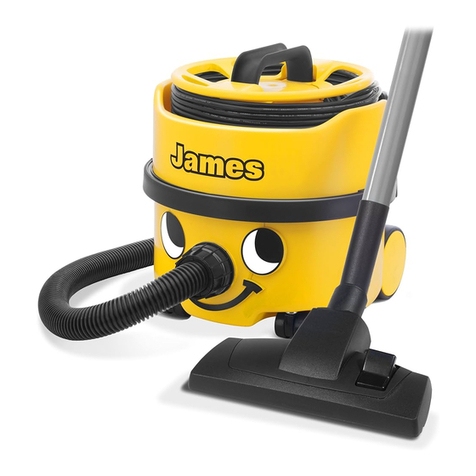
Edco
Edco Kit AH2 User manual
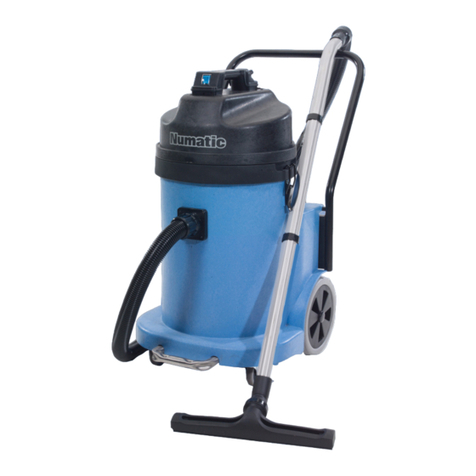
Edco
Edco WV 570 User manual
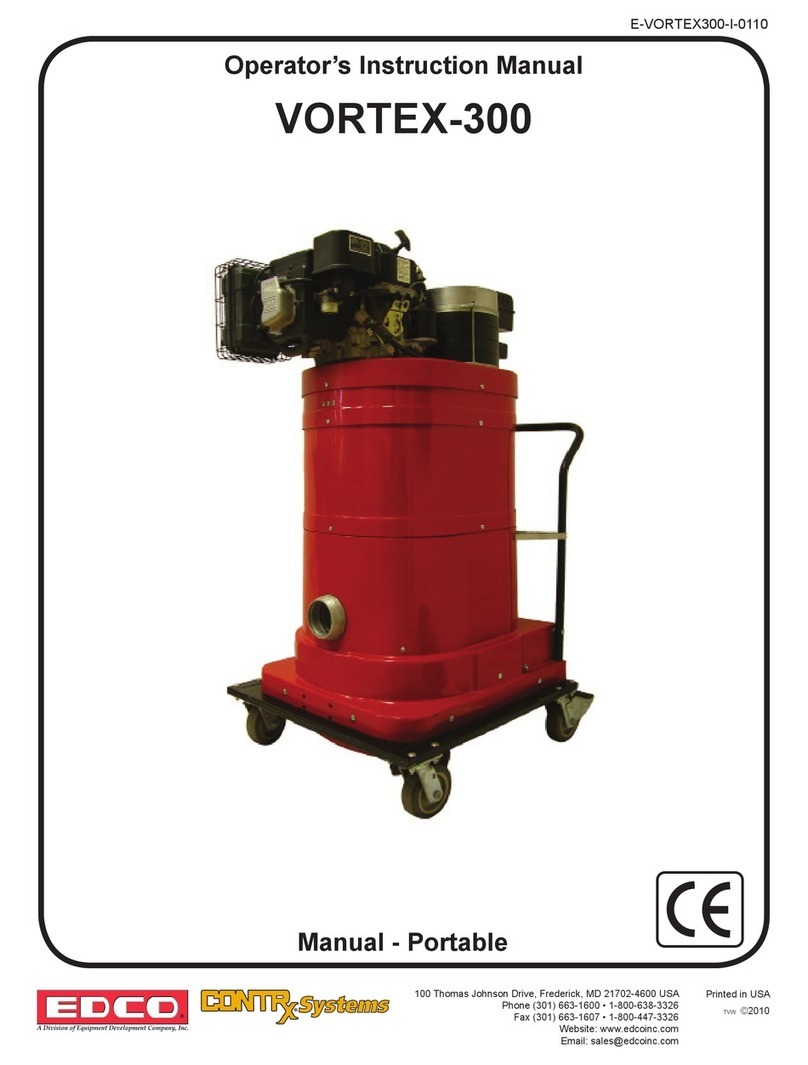
Edco
Edco VORTEX-300 Assembly instructions

Edco
Edco VAC-100 User manual
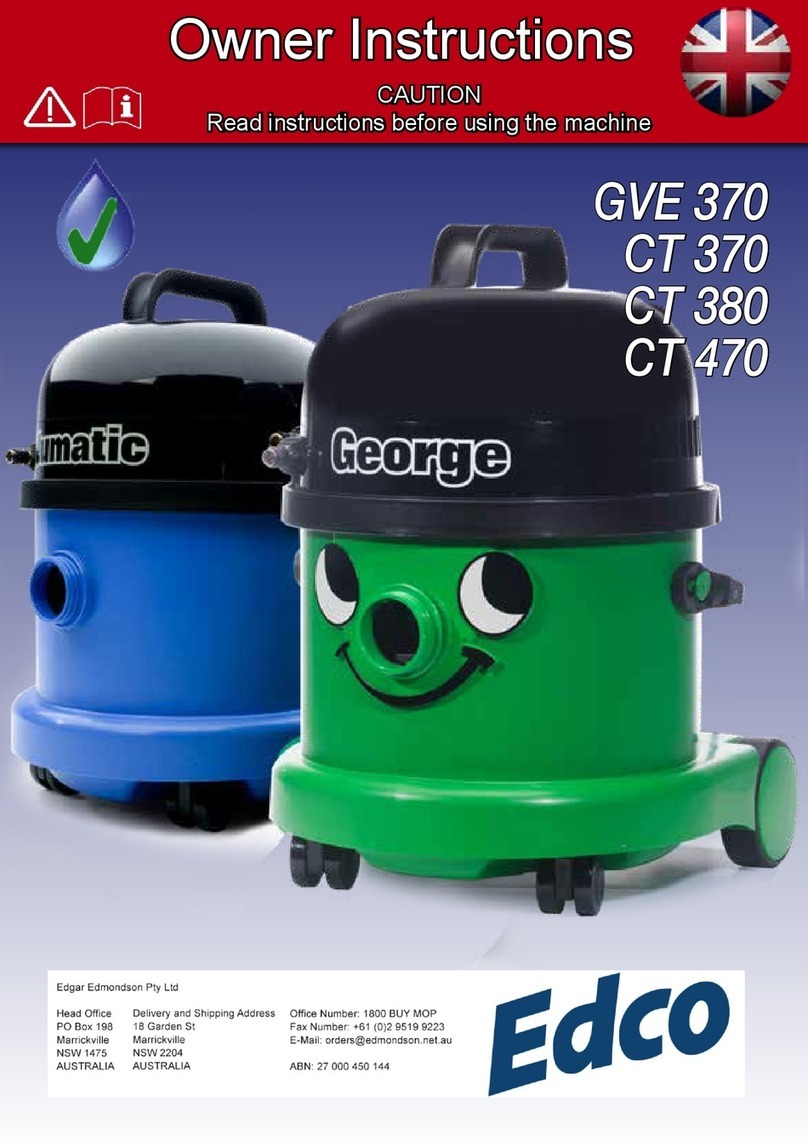
Edco
Edco GVE 370 User manual
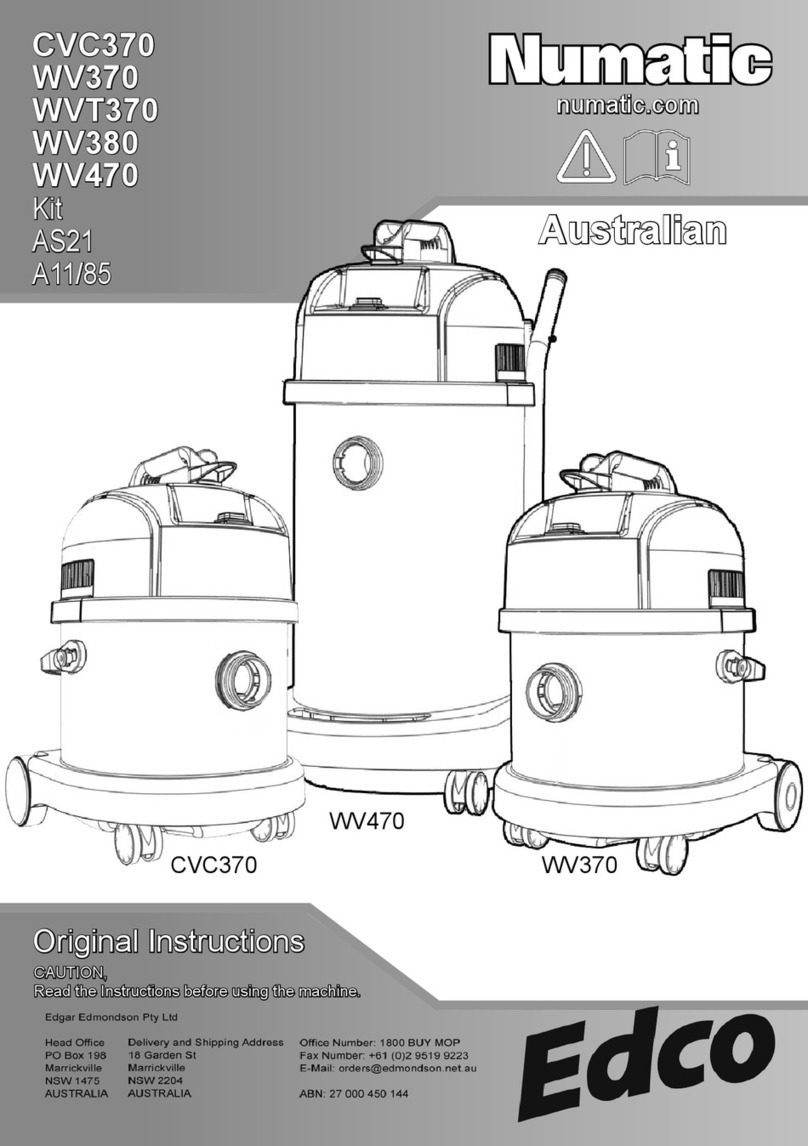
Edco
Edco Numatic CVC370 User manual

Edco
Edco SLURRY PRO VACUUM Assembly instructions
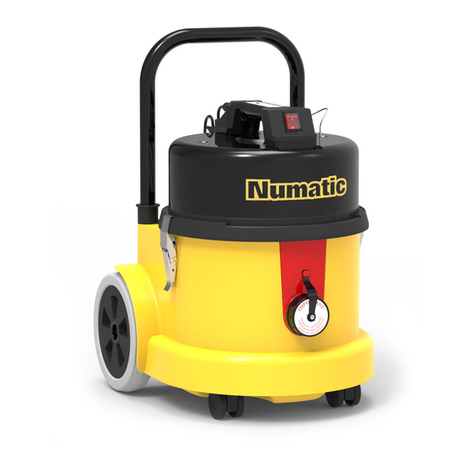
Edco
Edco Numatic HZC 390S-2 User manual
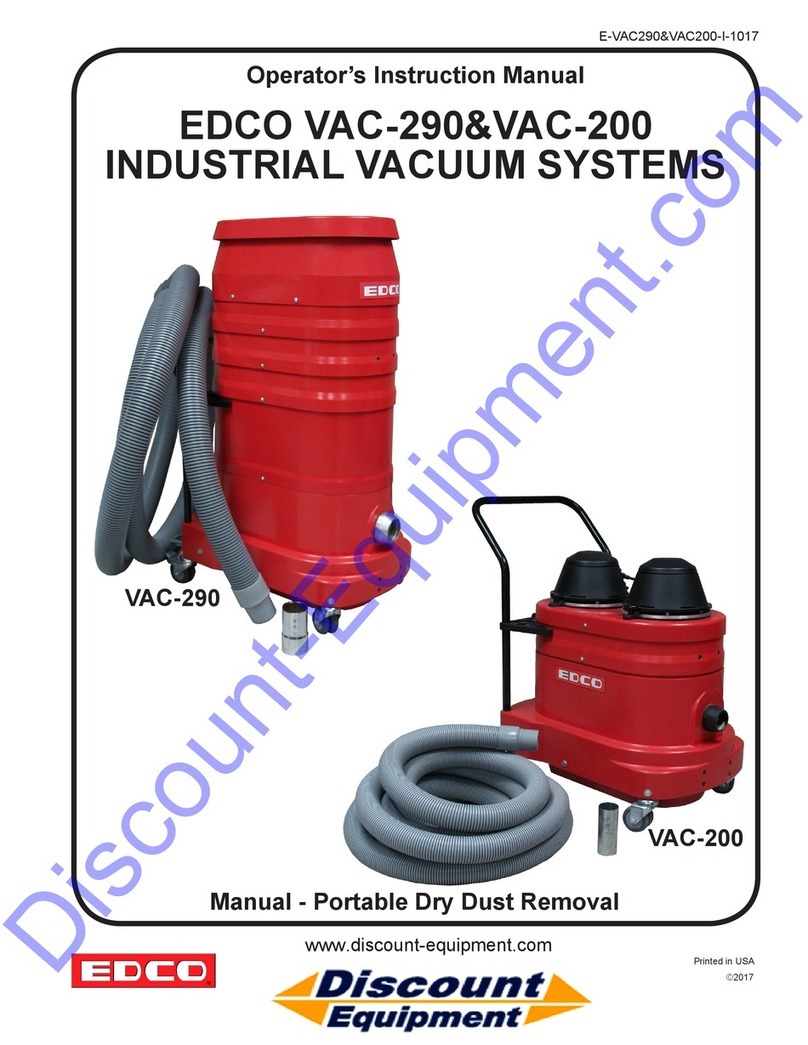
Edco
Edco VAC-290 Assembly instructions

Edco
Edco Vortex 300 Datasheet
